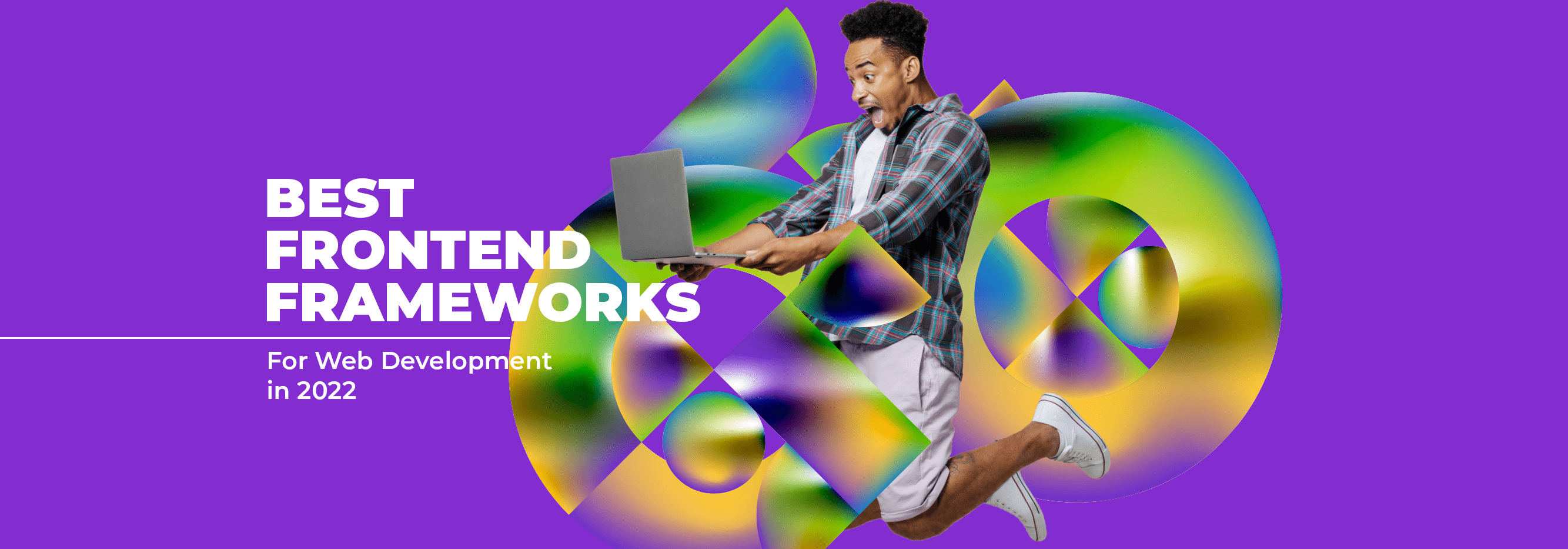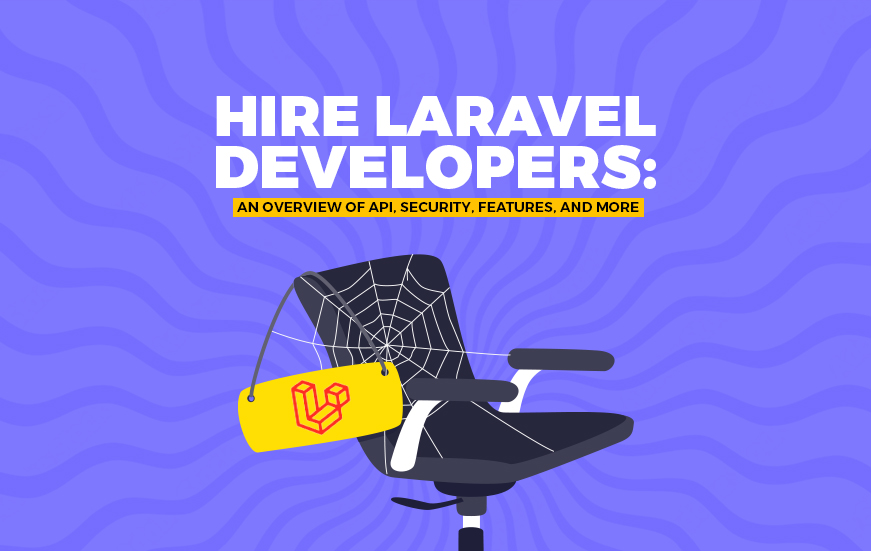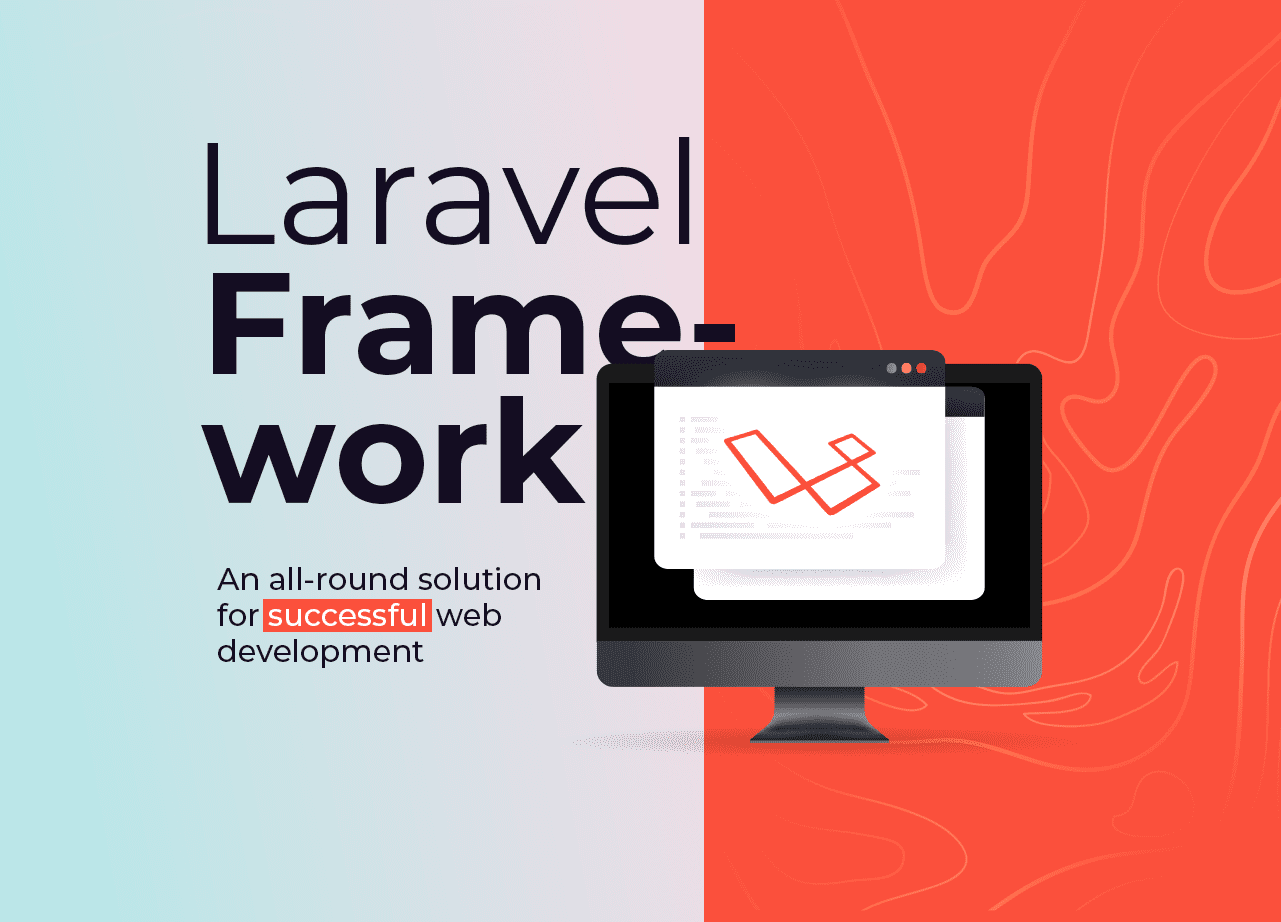“Customer comes first”, are the three golden words for any business. In the old days, customer satisfaction depended mostly on your sales representatives and stores. But that’s not the case anymore, the onset of the digital era has revolutionized the retail experience.
The paradigm shift towards the digital age has made it essential for businesses to deliver an excellent user experience on their websites supported by the best UI framework. Consumers gravitate towards a beckoning user interface.
Online shopping has reached an all-time high. The global e-commerce market has reached a staggering figure of $4.28 trillion. The number of online shoppers in the United States is projected to reach almost 285 billion in 2025.
From start-up companies to Fortune 500 brands, working with the best UI frameworks to create remarkable business websites, web apps & mobile apps has become key to success.
Of course, the performance and functionalities of the backend must be integrated well with the front end of the application- which the end-user uses. In this piece, let us specifically go over the best front-end frameworks in 2023.
Everything a user sees and operates when they click a link or put in a web address is termed as frontend.
So what are Frontend Frameworks?
Frontend Frameworks are used by web developers to create elegant, easy-to-use, and intuitive frontends. They are predefined structures of codes that provide the base for the creation of user interfaces.
Frontend web development is the process of converting data into a graphical interface using CSS, HTML, and JavaScript so that users can view and interact with the data.
Components that constitute a frontend framework:
- The best UI Frameworks are mostly composed of HTML, CSS, and JavaScript;
- A grid for designing and assembling the interface;
- Font styles and sizes;
- Website components like navigation bars,
- Templates,
- Buttons and side panels.
Benefits of Frontend Development:
- Features & web applications are considerably more responsive
- Real-time programming
- Easy to scale, learn and implement
- Rapid development speed
- Enhance user experience substantially
- Web applications are relatively more secure
For developers, it’s all about going with the best front-end framework that suits your business requirements perfectly.
Here are some of the most popular used frontend frameworks in the world.
Most Popular Frontend Frameworks
- React
- Angular
- Vue.js
- Svelte
- Preact
- Ember
- LitElement
- Alpine.js
- Stimulus
React, Angular, and Vue.js have enjoyed dominance in the field of UI development for years. But the popularity of other web UI frameworks is gradually rising as well.
Let’s have a look at the most demanded front-end frameworks in 2022
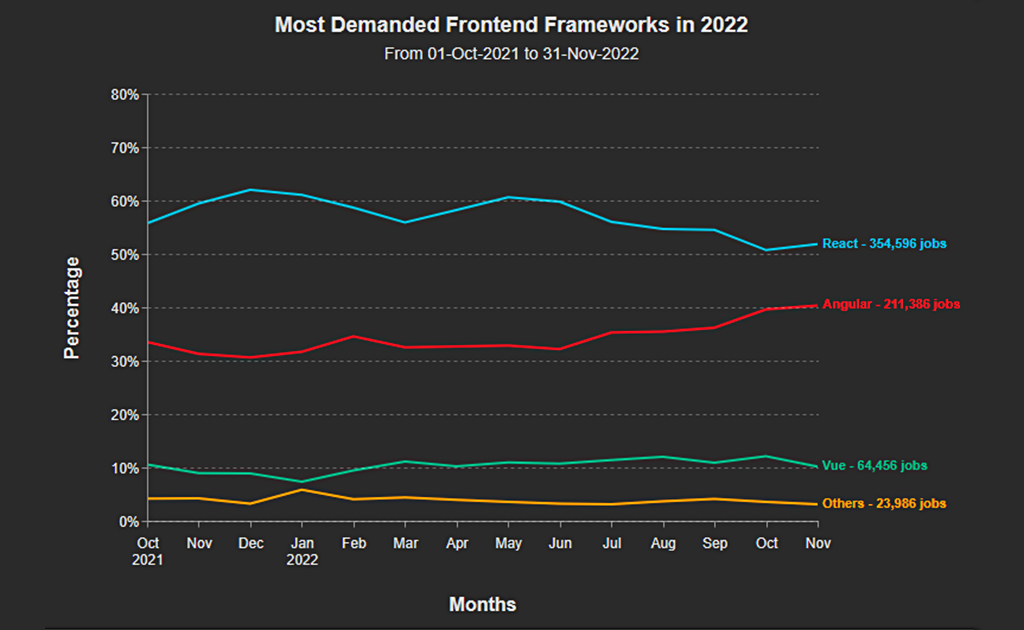
These stats clearly show that React, Angular and Vue.js are the most popular frontend frameworks among developers.
React is still the most favored as a web UI framework, but if we talk about Svelte, it is quickly rising to be one of the best front-end frameworks as well.
Each web UI framework is unique in its own way and has its advantages. These statistics may assist you to a certain extent, but sheer numbers aren’t enough for you to make the right decision while choosing the best front-end framework.
As a leading and trusted e-commerce solutions company, we at Communication Crafts have more than 17 years of proven experience in the field of web development, especially front-end development.
We work with cutting-edge technologies to create state-of-the-art web solutions that help our clients move their businesses forward.
Our expert developers have created this guide for everything important you need to know about the best frontend frameworks for web development.
Here’s a video by Coding Tech that compares the top three JavaScript-based frontend frameworks:
So let’s delve deeper into each of these frontend frameworks, shall we?
Top 10 Frontend Frameworks in the Year 2023:
1. React
Mark Zuckerberg’s Favourite Framework

React is an open-source web UI framework created by Facebook in 2013. It quickly became one of the most popular front-end frameworks for UI development. It is adored by web developers because it requires minimal effort in coding and its ability to provide an outstanding user experience, making it one of the best UI frameworks of all time.
Programming languages used: JavaScript/JSX (HTML+JavaScript syntax)
With 203k stars and 42.3k forks on GitHub, React is used by 1.2 million websites and 422k unique domains.
Here’s an informative video from “Programming with Mosh” explaining what is React and why is it so popular. Check it out
When should you use React:
- Single-page or cross-platform application development
- Data Visualization Tools
- Social networks
- Retail websites
- Web apps
- Messaging apps
- Blogs (Personal or professional)
PROS of React
- Easy to learn and use: Developers familiar with JavaScript can learn to use React in a matter of days. 69.7% of developers prefer JavaScript-based frameworks over other programming languages.
- Virtual Direct Object Model (DOM): The tree-like structure of an HTML program is known as DOM. The user’s actions on a website trigger an update that rewrites the entire DOM- requiring more resources. A virtual DOM works more efficiently because it changes only the elements that need manipulation.
- Requires less coding– Easy to create highly functional web UIs
- Reusability: React has reusable HTML codes that make a developer’s life quite easy. It is easier to make and maintain web UIs because of this feature.
- Downward data flow: React framework’s data flow is relatively simple. It has a straightforward downward data flow that is easy to track and work with.
CONS of React :
- Continuous updates: Developers have to constantly re-learn new ways of coding because web UI framework changes at a very rapid pace.
- Poor documentation: The extension libraries are not efficiently updated by the supporting community.
- JSX complications: React uses syntax that is a combination of HTML and JavaScript. It has a steep learning curve and is difficult for amateur developers to work with.
Companies that use React web frontend framework:
- Uber
- Airbnb
- Netflix
2. Angular
Google’s Special Project
Angular is a Single Page Application (SPA) web UI framework made by Google in 2010. It is backed up by a large community and based on the TypeScript language. Its basic purpose is to simplify the development of web and mobile applications.
Click here if you’re looking for impeccable front-end development using AngularJS.
Programming languages used: TypeScript
With 74.7k stars and 19.6k forks on GitHub, Angular is used by 388k websites and 198k unique domains.
When should you use Angular:
It is primarily used for making dynamic and interactive single-page websites or applications, although it can be used for much more.
- Progressive Web Application (PWA)
- Large-scale projects or websites
- Websites with interactive content
- Upgrade designs of old web pages or applications
- Boost user experience of an existing website
PROS of Angular:
- Two-way data binding: Angular has a Model-View-Controller build. This feature synchronizes the data in the model and the view- reducing the extra code needed. Thus reducing development time.
- Community: Angular is backed by Google. And that is why its community is trusted to provide sufficient materials and third-party tools.
- Directives: This allows the developers to assign specific behaviors to the Direct Object Model (DOM) to create effective HTML content.
- Customizable elements: Modules and elements of Angular are fully customizable, allowing the developers enough freedom to design and develop as per their wishes.
CONS of Angular:
- Difficult to learn: The learning curve of Angular is quite steep. It takes a while for new developers to learn complex coding languages, integrations, and customizations.
- Angular is a heavy-weight framework when compared to React and Vue, increasing its complications.
Companies that use Angular web frontend framework:
- Microsoft Office
- PayPal
- Forbes
- Gmail
- Santander
3. Vue.js
The Progressive JavaScript Framework

Vue.js was officially released in 2014 by Evan You. It was created in an attempt to make a lightweight custom tool that features the best parts of Angular, making it one of the most efficient and best UI frameworks for fast-paced web development.
It is generally used to create one-page applications and web UIs, using an open-source progressive JavaScript framework.
Programming languages used: JavaScript
With 186k stars and 29.6k forks on GitHub, VueJS is used by 280k websites and 174k unique domains.
PROS of Vue.js:
- Small size: Vue.js has a relatively small size. It is just 20KB in size, making it easier for developers to instantly download its files. Also, it still outperforms most hefty web UI frameworks;
- Simplicity: New or inexperienced developers can learn to use Vue.js fairly quickly. If they are already familiar with JavaScript, it’ll take no time for them to get familiar with Vue.js;
- Integration: Vue.js can be used or integrated into most existing apps easily.
- Customization: Each segment of Vue.js can be assigned different functions.
CONS of Vue.js:
- Community: Vue.js is a relatively new frontend framework and it is not backed up by a large community. Therefore, it is not efficiently updated if need be.
- Language Barrier: It is supported by Chinese developers, hence the framework is in Chinese, making it difficult for non-China developers.
- Limited plugins: Developers don’t get access to properly supported plug-ins, because Vue.js is still a bit under-developed.
Companies that use Vue.js web frontend framework:
- Nintendo
- Trivago
- Zoom
- BMW
4. Svelte
A framework without the framework
It is a relatively new front-end framework. And given that, its popularity seems to be on a tremendous rise in the past couple of years.
Being a compile-time web UI framework, it requires less coding and has no virtual DOM. Direct and specific changes are made to the real DOM with a unique way of compiling data.
Svelte is typically suited to create small-sized web apps with fast performance levels and interactive experiences. And it can also be used to make separate components for already existing apps.
Programming languages used: JavaScript/TypeScript
With 156k weekly downloads, Svelte has 48.6k stars and 2.3k forks on GitHub.
PROS of Svelte:
- Developers love to use Svelte because its syntax template is easy to read and understand
- Offers high reactivity
- Relatively small size
- Minimal learning curve
- Svelte compiles the work to vanilla JavaScript, deleting the need to work in the browser.
CONS of Svelte:
- Unlike, React and Angular, Svelte is not backed by any MNC
- Limited tools and packages
- Although it is popular among developers, it does not have large community support.
Companies that use the Svelte web frontend framework:
- Spotify
- The New York Times
- Semrush
- OLX
- IBM
- GoDaddy
5. Preact
A 3KB Alternative to ReactJS- The Lightest Framework
Preact is an experimental alternative to React created by Jason Miller. With a size of 3KB, it is a lightweight version of React with similar features and a JavaScript framework.
Many developers are switching over to Preact because of the compact size and accessibility across all browsers, making it one of the most feasible and best UI frameworks.
It is ideal for building single-page applications.
Programming languages used: JavaScript
With 693k weekly downloads, Preact has 29.5k stars and 1.6k forks on GitHub
PROS of Preact:
- Small size: It is one of the most lightweight web UI frameworks with a size of just 3KB.
- Command Line Interface: Preact CLI allows developers to create challenging projects at a faster pace.
- Compatibility: Developers have the freedom to use Preact in already existing web pages and applications.
- Efficiency: Takes minimal memory, decreasing the work of the garbage collector.
CONS of Preact:
- Small community: Preact has approximately 200 contributors on Github, which is fairly low.
- PropTypes and createClass have not been implemented in Preact, which are key features in React.
Companies that use Preact web frontend framework:
- Groupon
- Uber
- Pepsi
- Lyft
- Dominos
6. Ember
A Framework for Ambitious Web Developers

Ember was created to meet the increasing demands of day-to-day modern technologies. It is an open-source, Model-View-ViewModel (MVVM) framework developed by Sproutlt in 2011.
It combines the best features of other most popular frontend frameworks like Angular and React, and that makes it an efficient tool for making elaborate multi-page applications. It can be used for making small and large-scale applications quickly.
Programming languages used: JavaScript
With 21.9k stars and 4.2k forks on GitHub, Ember is used by 12.8k websites and 5.2k unique domains.
PROS of Ember:
- Easy to use with high readability of documents
- Two-way data binding, automatically updating the UI when the data is updated or altered
- Well-organized framework structure
- Satisfactory performance for high-end applications
- Ember CLI: Command Line Interface boosts versatility and efficiency
- A personal debugging tool to identify and eradicate bugs automatically
CONS of Ember:
- It is a heavy web UI framework, which is too complex for lightweight applications.
- It has a small community of developers, which makes it difficult at times to get help and the desired resources.
- It has a steep learning curve.
- Too heavy for small-scale work.
Companies that use Ember web frontend framework:
- Twitch
- Accenture
- OYO rooms
- TED
- Netflix
- Microsoft
7. Lit Element
Simple & Fast Framework for Web Components
Lit Element is a simple and effective base class for building lightweight and fast web components that can be compatible with any web page. It works in all web browsers: Chrome, Firefox, Edge, and Safari.
Lit Element provides scoped styles, reactive states, and a tiny declarative template system that’s expressive and fast.
Programming languages used: JavaScript/TypeScript/HTML
With 268k weekly downloads, Lit Element has 8.4k stars and 483 forks on GitHub.
Pros of Lit Element:
- Lightweight structure
- One-way data binding
- Ease of building web components with pre-built web UI components
- HTML templates are defined and rendered using Lit-HTML
- Lightning-fast DOM updates because only the dynamic parts of the UI are re-rendered with Lit-HTML
Cons of Lit Element:
- Requires a bundler or a server-side transform
- Small community
Companies that use Lit Element web frontend framework:
- YouTube
- Coca-Cola
- McDonald’s
- USA Today
- Bloomberg
8. Alpine.JS
New & Lightweight JavaScript Framework
Alpine.JS is a rugged and minimal frontend framework for adding JavaScript behavior to HTML markups. It provides the declarative and reactive qualities of the most popular frontend frameworks like Vue, React, and Angular at a much lesser cost.
It is ideally chosen for projects that need minimal JavaScript, when you need a few components for your webpage like sidebars, tabs, dropdowns, image selection, etc.
Programming languages used: JavaScript/HTML
With 46k weekly downloads, Alpine.JS has 17.5k stars and 729 forks on GitHub.
Pros of Alpine.JS:
- Lightweight with a library size of 4KB
- Bridges the gap between vanilla JS (jQuery) and extensive virtual DOM frameworks like React
- Effective API for interacting with third-party libraries
- Easy to use
- Responsive community
Cons of Alpine.JS:
- DOM is not updated when a change is made in any non-interactive event
- Not efficient while working with nested components
- Not intended for large or single-page web pages
9. Stimulus
A Modest JavaScript Framework
Stimulus is a minimalistic and modest framework designed for sprinkling JavaScript and adding behavior to HTML to augment and enhance it. It can be easily paired with Turbo to create a complete solution for efficient web applications without expending much effort.
Programming languages used: JavaScript/HTML/TypScript
With 142k weekly downloads, Stimulus has 10.6k stars and 283 forks on GitHub
Pros of Stimulus:
- Lightweight structure
- Reusable components
- Easy to use with high readability
- Simplicity
- Shallow learning curve
Cons of Stimulus:
- Can’t be used for full-fledged web pages
- Small community
- Limited tools and documentation
Companies that use Stimulus web frontend framework:
- Veue
- Muna
- Festalab
- Transcripto
- Stamped Technologies
10. jQuery
One of the oldest and most popular frameworks among developers. It is lightweight, quick, feature-rich, and small. It is a cross-platform library created with the goal of simplifying client-side HTML scripting. jQuery has a motto that goes, “Write less, Do more”.
Pros of jQuery:
- Easy to learn
- Open Source
- Large Community Support
Cons of jQuery:
- Unsuitable For Complex Projects
- Debugging Issues
- Limited Functionality
These were the top 10 front-end frameworks in 2023. Now let’s discuss the ongoing trends in frontend development…
What are the Ongoing Frontend Development Trends in 2023?
Every frontend framework is unique, and different web development requirements align with specific frameworks. But the best way to deliver satisfying and appealing user experiences is by understanding the emerging trends.
There are 3 top trends in 2023 that web developers follow across the globe:
- Micro Frontend Architecture
- Component Driven Development
- JAMStack Development
Let’s discuss each of them in detail…
Micro Frontend Architecture:
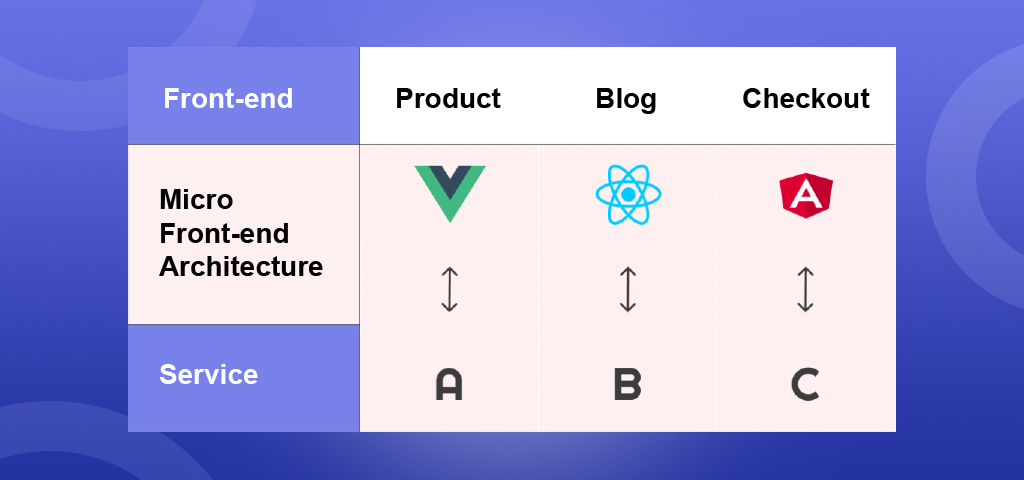
Micro Frontend Architecture bifurcates a full-fledged web project into systematic “micro apps”. To understand its benefit in simpler terms, developers with different technical skill sets can collaborate on a single project using the micro frontend architecture.
Micro front end facilitates the use of multiple technologies simultaneously without affecting the original web product plan. Furthermore, this architecture allows smooth deployment, a rapid development process, and freedom of choice while using different frontend frameworks.
When it comes to web development, no technology or trend is flawless. Complex testing, accessibility integration, and config management are some of the drawbacks that web developers have to overcome for successful micro frontend development. Despite the hurdles, this architecture is popular among many front-end developers all over the world.
Component Driven Development (CDD)
CDD is not an emerging trend, it has been around for years. But it would be foolish not to discuss such a prevalent and effective front-end development trend.
In a nutshell, component-driven development enables you to separate the web development structure into different components or modules. Each module is responsible for a different function in the web development structure. This is a major perk as it lets you alter or remove different components without affecting the whole architecture.
For example, ReactJS uses this component-based development process. This frontend architecture is embraced by many other popular frontend frameworks as it simplifies the development process by a large margin.
JAMStack Structure:

JAMStack is a one-of-a-kind structure mainly used for developing static web pages. API is used instead of the back-end for generating content. This architecture allows your static web page to function faster and also makes it easier to handle for the developer.
What does JAMStack stand for?
J – JavaScript – Responsible for front-end operations
A – API– Generating content and data from third-party services
M – Markup – Organizing content on the web page
The term “Stack” is used to define the blend of technologies used in the development process. JAMStack is one of the most efficient ways to develop single-page websites, and that’s why developers love it. It can be used with many other combinations of frameworks and services, provided that it implements the JAM architecture.
Summing Up
There have been more than 500 million digital buyers globally from 2016 to 2023. Making it an absolute necessity to have an intuitive, interactive, seamless, and simple webpage or application for your audience.
Your business is unique, for which your requirements will be different and we totally understand that.
These are the top 9 frontend frameworks you can use to develop your web UIs for your websites and applications.
We hope this article has helped you to select the most suited front-end framework for your next web development project.
We know there are too many options to choose from, so if you’re still confused, don’t worry, reach out to our expert web developers and get the right advice regarding frontend development that’ll help move your business forward.
Communication Crafts offers a wide range of web development services that include bespoke eCommerce development, web application development, CMS development, theme development, UI/UX design, website maintenance/support, and much more.
We won’t build the online presence your company needs, we’ll build the online presence your company deserves!
Frequently Asked Questions
Which frontend framework should I use in 2023?
According to the data from the state of JavaScript, the following frontend frameworks have been in the top 3 in terms of usage since 2017:
- ReactJS
- AngularJS
- VueJS
But this doesn’t mean that you can’t explore other frameworks in 2023. Other frontend frameworks like Svelte, Ember, Lit, Preact, etc. may end up being more suited for your project specifically. Understand the benefits and drawbacks of the top front-end frameworks, then decide which one suits your specific web development needs.
What are frontend frameworks?
The frontend framework is an all-inclusive software package that simplifies and expedites the front-end development process. This type of framework includes reusable code modules, in-built interface blocks, and standardized technologies that make the overall process much easier.
Which frontend framework is most used?
React. js, developed by Facebook and actively supported by a large community of developers, is the most used frontend framework globally. It is a free and open-sourced JavaScript library that is used for developing high-functioning user interfaces.
What is the best frontend framework for 2023?
Every frontend framework is unique with distinct benefits and drawbacks, that’s why it is difficult to determine which one is the best. Different frameworks are ideal for different purposes. Conduct in-depth research on the top 5 frameworks in 2023 to make informed decisions:
- ReactJS
- AngularJS
- VueJS
- Svelte
- Preact
Which frontend framework can be used for large-scale applications?
The development of large-scale web apps requires full-featured frameworks along with strong support communities. Such frameworks are AngularJS, ReactJS, VueJS, and EmberJS.
Which frontend framework can be used for small web applications?
Small-scale web pages can be developed with any of the front-end frameworks mentioned in this blog. But Svelte and Preact are the most preferred frameworks for small web applications.
Looking for a team of the best remote developers?
You’re in the right place!
 Blog Communication Crafts
Blog Communication Crafts